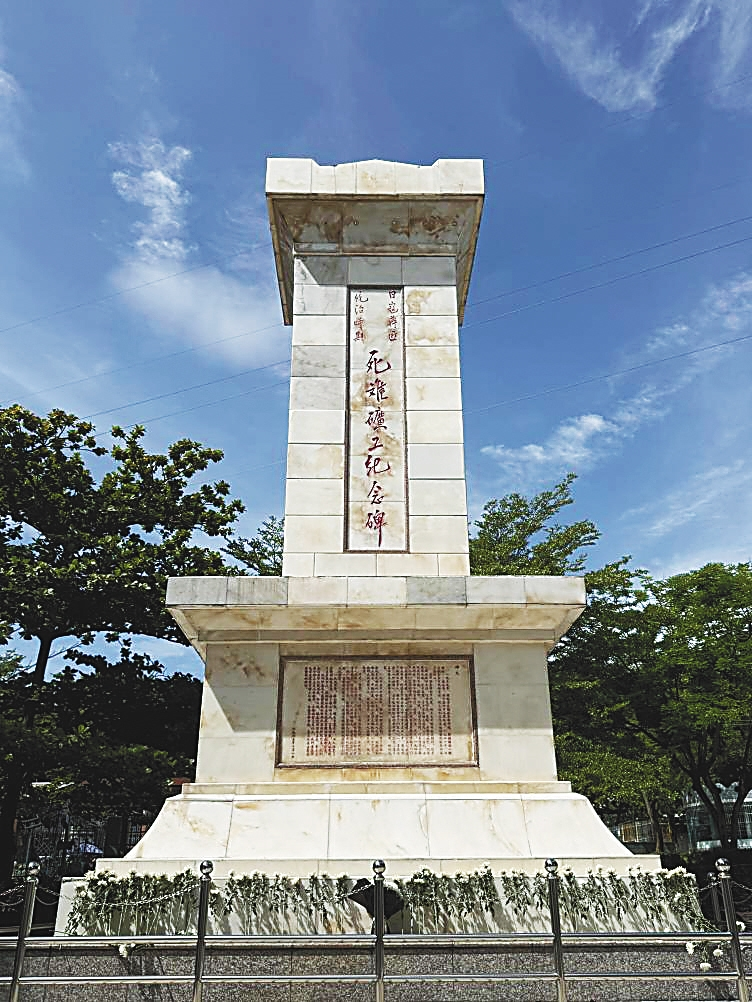The Unforgettable History of the Japanese Invasion of Hainan II
2025-08-01 18:51:42
Editor's note:
In February 1939, Japanese forces launched a full-scale invasion of Hainan. Over the following six years, they carried out relentless massacres of innocent civilians and brutal suppression of resistance forces, perpetrating one horrifying atrocity after another.
Today, as we revisit that painful chapter of the past, we are reminded that peace is hard-won. The tragedy must never be forgotten, and such horrors must never be repeated. This land, once drenched in blood and tears, will one day, through our unwavering resolve to remember the past, become a beautiful homeland basked in peace.
Chengmai: the Shatudong Massacre
A memorial stele documenting the "Shatudong Massacre" now stands solemnly in Shatudong Village, Qiaotou Town, Chengmai County. Covering an area of 1,200 square meters and rising to a height of 8.7 meters, the monument commemorates one of the most brutal atrocities committed during the Japanese invasion of Hainan. Among the many massacres, the three separate incidents in Shatudong stand out for their scale and savagery.
Shatudong is located on the eastern edge of Qiaotou Town in Chengmai County. This alluvial plain, surrounded by the sea on three sides, was once home to 13 villages. In 1941, a massacre that shocked all of Hainan — the "Shatu Massacre" — took place here. The area, once home to over 2,100 residents, was subjected to burning, killing, and plundering by the Japanese army. Over 1,300 villagers were murdered, property was looted, and houses were razed, leaving Shatudong in a ghastly state: "houses turned to ruins, corpses everywhere; the stench of blood filled the air, no village without mourning, no home without weeping."
In May 1941, Lin Mingcheng, the son of Lin Guishen, the Japanese puppet regime's Western Route General Commander, was escorting a fleet of merchant ships loaded with cargo from Xinying Port in Lin'gao to Haikou. Upon learning this news, Huang Kunxin, commander of the Chinese Kuomintang (KMT) guerrilla battalion in Lin'gao, led a squad from Shatudong out to sea to intercept the ships. The guerrillas seized the cargo on board and killed Lin Mingcheng. After the incident, Lin Guishen suspected that the local people of the Shatu region were responsible for the death of his son. Seeking revenge, he requested Japanese troops to carry out a retaliatory sweep of the area.
On the morning of July 7, the Japanese assembled over 200 soldiers, divided into 10 trucks, and stormed into Shatudong to carry out Lin’s request. As soon as they arrived, they completely sealed off the area. Under the pretext of inspecting "common citizen certificates" or holding a meeting, they herded the villagers together and then slaughtered the innocent en masse. Some were stabbed with bayonets, others were mowed down by machine gun fire. Any movement was met with a hail of bullets; anyone in sight was killed without hesitation. Some women were gang-raped and died on the spot…
After a whole day of carnage, residents of ten villages across the Shatu region were slaughtered. Only three villages, Muchun, Xiaomeiliang, and Fuli, escaped the carnage due to their remote locations. And that was only because the Japanese were tired of their killing spree and withdrew their troops before reaching them. The worst-affected villages were Shengyan and Fuliu. Shengyan had over 400 inhabitants, of whom 314 were massacred. The village’s private elementary school had more than 60 students; only three survived, presumed dead by the Japanese after they fell unconscious from their injuries. Fuliu had 298 villagers, of whom 264 were murdered.
In November of the same year, the Japanese dispatched two more waves of troops to mop up the Shatu area. The three massacres saw catastrophe befall every village in the region. In total, over 1,300 innocent residents were killed, 58 houses were burned down, and 600 head of cattle were robbed by the intruders.
Changjiang: Memorial to Fallen Miners at Shilu Iron Mine Park
Rows of white chrysanthemums are neatly arranged around the base of the Memorial to the Fallen Miners in Changjiang’s Shilu Iron Mine National Mining Park. In Hainan’s Changjiang County, this monument serves not only as a place of mourning but also as a silent lesson of history.
"I first saw this monument in the park when I was just seven years old", says Li Weiwen, who was born in 1968 and grew up in the mining town of Shilu. Now retired, Li has witnessed the numerous changes at the mine site over the decades. He also listened to his elders recount the miners’ tragic experiences during those dark years from early on in his childhood.

Memorial to the Fallen Miners at the Shilu Iron Mine National Mining Park in Changjiang. (Photo by Zhang Mao, Hainan Daily)
On one side of the monument stands a corridor, where images and inscriptions on the wall vividly document that dark chapter in history.
In February 1939, the Japanese forces landed on Hainan Island. Shilu Iron Mine became a prime target of their frenzied plunder. The invaders conscripted over 40,000 Chinese laborers from across China's southeastern coast and from Hainan itself, forcing them into inhuman hard labor. Savage exploitation, squalid living conditions, and rampant disease snuffed out the lives of more than 30,000 miners. By the time Japan surrendered in 1945, only around 5,800 of them were still alive.
However, Japan's capitulation did not immediately bring deliverance. It was not until Hainan Island’s liberation in May 1950 that Shilu Iron Mine’s fate finally began to take a turn for the better.
"The good life we enjoy today was paid for with the lives of that generation. We mustn’t forget them!" Li Weiwen says with deep emoti
南海网版权声明:以上内容由南海网原创生产,未经书面许可,任何单位及个人不得以任何方式或理由对上述内容的任何部分进行使用、复制、修改、抄录、传播或与其它产品捆绑使用、销售。如需转载,请与南海网联系授权,凡侵犯本公司版权等知识产权的,本公司必依法追究其法律责任。电子邮箱:nhwglzx@163.com.